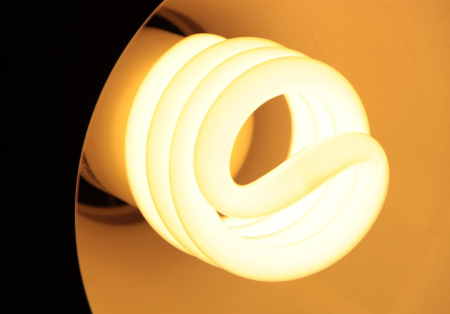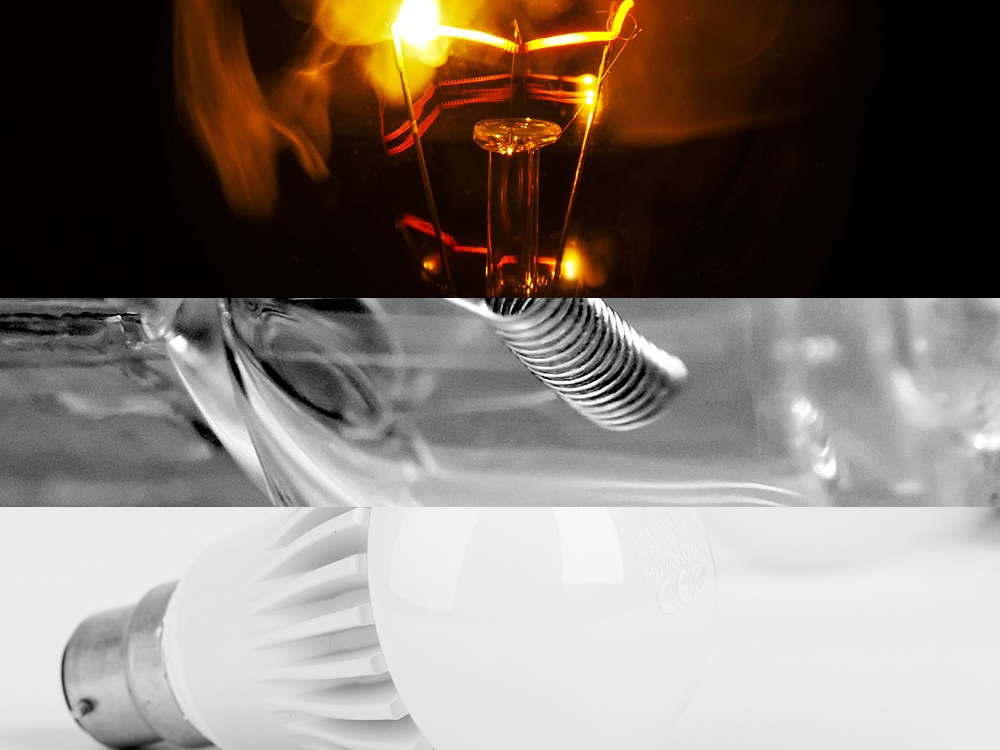The development of light bulb technology dates back to the 1760s when Ebenezer Kinnersley heated a wire and it glowed, due to the incandescence effect. Joseph Swan first installed bulbs for residential uses in the early 1880s. With his bulbs, the Savoy Theatre was the first public building illuminated with incandescent lights in 1881, and Mosley Street, in Newcastle upon Tyne, UK was the first street with electrical lighting. LED vs CFL vs Incandescent Light Bulbs is a question many people think about. Let’s dig deep into this topic.
With carbonized bamboo filaments, Thomas Alva Edison developed the first commercially viable light bulb in 1880 with a much better lifespan of about 1,200 hours.
In 1955, Emmett Wiley and Elmer Fridrich made a halogen light bulb with a tungsten filament and transparent quartz envelope mixed with some amount of halogen elements. Halogen light bulbs offer up to 5,000 hours of lifespan and it’s about 30 percent more efficient than traditional incandescent bulbs. Current energy-saving lightbulbs can be dimmed and you can adjust them to set an ideal lighting condition.
Nick Holonyak, Jr. worked on the first LED with visible emission of light in the early 1960’s. LED uses semiconductors directly to produce photons of light particles, without using any heated element that can burn out. This means, that LED bulbs are more energy-efficient and have an excellent lifespan, which may reach 100,000 hours. First LEDs emitted only visible red light, but today, LED bulbs have become a mature technology that can be integrated into your smart home network. LED bulbs are also greener because they don’t contain any toxic metal or substance.
CFL (compact fluorescent light) is a newer light bulb technology, developed by Edward E. Hammer in 1976. It was a response to the energy crisis in 1973 and essentially fluorescent tubes with a spiral shape. Although still less efficient than LED, CFL bulbs are 75 percent more efficient than typical incandescent bulbs, and they last ten times longer. In the 1970s, LED technology was not yet fully developed and CFL technology was intended to replace incandescent bulbs because they use the same fittings.
LED vs CFL vs Incandescent Light Bulbs
LED light bulbs: LED light bulbs use around 85% less energy than incandescent bulbs and last around 25 times longer. They produce a bright, white light and are available in a variety of shapes and sizes.
CFL light bulbs: CFL light bulbs are more energy efficient than incandescent bulbs and last up to 10 times longer. They produce a warm, soft light and are available in a variety of shapes and sizes.
Incandescent light bulbs: Incandescent bulbs are the most common type of light bulbs and are the least energy-efficient. They produce a warm, soft light and are available in a variety of shapes and sizes.
Lumen & Wattage Comparison
Wattage is a measure of how much electrical energy your bulb uses. Newer bulb technologies are more efficient, so they consume far less electricity to produce similar or higher amounts of luminosity. It’s recommended to use bulbs with a lower wattage because it lowers your home’s carbon emissions and energy bills. On the other hand, if you want better brightness, you need to choose a bulb with a higher lumen value. For a bedroom, you need about 15 lumens per square foot and for a living room, you need about 40 lumens per square foot. For work areas, such as the kitchen, home office, or workshop, you need about 70 lumens per square foot.
But when choosing light bulbs, you should be aware that higher wattage doesn’t always give you higher brightness. Wattage is only one variable. Other factors also determine the measure of brightness or lumen value of your bulbs. Incandescent, halogen, CFL, and LED bulbs are based on different technologies that affect energy efficiency, lumen value, and lifespan. Materials used for your bulbs also have an effect on energy efficiency and brightness level. For incandescent bulbs, materials used for filaments, such as carbon, tantalum, osmium and tungsten, have different characteristics. This also applies to LED light bulbs, because manufacturers use different semiconductors. V-Tac LED lights produce about 90 lumens per Watt, while ultra-efficient Philips LED bulbs give you more than 200 lumens per watt.
| Lumens | Incandescent Watt | CFL Watt | LED Watt |
|---|---|---|---|
| 400 – 500 | 40W | 8 – 12W | 6 – 7W |
| 650 – 850 | 60W | 13 – 18W | 7 – 10W |
| 1000 – 1400 | 75W | 18 – 22W | 12 – 13W |
| 1450 – 1700+ | 100W | 23 – 30W | 14 – 20W |
| 2000+ | 150W | 30 – 55W | 25 – 28W |
The wattage shown on the packaging may further confuse you. When it says 60 Watts on the packaging of CFL or LED bulbs, they may actually consume 12 Watts or less. It’s just a way to compare CFL and LED bulbs with incandescent bulbs, in terms of brightness. So, if you are using 60-Watt incandescent bulbs at home right now, you know what CFL or LED bulbs to choose as replacements. Because CFL and LED bulbs have far lower wattage, they won’t exceed the maximum wattage rating of your current fixtures.
Cost efficiency: LED vs CFL vs Incandescent
As mentioned above, due to differences in technology and material used, higher wattage doesn’t always give you more brightness. A 75W LED bulb is far brighter than an incandescent bulb with similar wattage. Each Watt of incandescent bulb gives you between 9 to 13 lumens. Similarly, you get between 12 to 19 lumens for halogen bulbs, 36 to 65 lumens for CFL bulbs, and 55 to 210 lumens for LED bulbs, with each Watt of electrical power, consumed. It’s obvious that CFL and LED bulbs are far more efficient than incandescent and halogen bulbs. If you want a 700-lumen bulb, you need a 60W incandescent bulb, 42W halogen bulb, 12W CFL bulb, or 10W LED bulb. So, wattage is a measure of brightness only if you compare bulbs with the same technology and also from the same manufacturer.
If energy efficiency is your top priority, you should choose bulbs with the highest lumens per Watt (lm/W) value. The higher the value, the more efficient your bulb is. If you have the budget, it is recommended to get quality LED bulbs to achieve maximum energy efficiency. However, CFL bulbs can be a sweet spot, if you want to spend less on initial cost, but LED bulbs will definitely save you money in the long run.
| LED vs CFL vs Incandescent Cost | Incandescent | CFL | LED |
|---|---|---|---|
| Watts used | 60W | 14W | 7W |
| Average bulb cost | $1 | $2 | $4 |
| Average lifespan | 1,200 hours | 8,000 hours | 25,000 hours |
| Bulb changes in 25,000 hours | 21 | 3 | 1 |
| The total purchase price for 20 y period | $21 | $6 | $4 |
| Cost of electricity (25,000 hours at $0,15/kWh) | $169 | $52 | $30 |
| Total estimate cost over 20 years | $211 | $54 | $34 |
The average electricity rate for residential areas in the US is around 15 cents per kWh. So, it is straightforward to calculate the overall costs of using different types of CFL bulbs. Let’s assume you need ten 700-lumen bulbs at home, which are turned on 12 hours daily. With these assumptions, ten 60W incandescent bulbs consume 7.2 kWh per day or 2628 kWh per year, which costs you $394 per year in electricity bills. Ten 42W halogen bulbs will cost you $275 per year in electricity costs, while ten CFL and ten LED bulbs, will cost you only $79 and $66, respectively. You need to spend about $50 to buy ten LED bulbs and only $10 for ten incandescent bulbs, but the difference in electricity costs through their lifetime far exceeds that.
LED equivalent to Incandescent light bulbs
Before you start looking at this table LED vs Incandescent light bulbs, thing you should know is that LED equivalent wattages to traditional light sources can only be approximate. The truth is, they will vary depending on the color temperature and quality of the bulbs being compared. When comparing different light bulb sources, the best way is to compare the lumens that each light source produces, in order to gain a true like-for-like comparison.
Incandescent light bulbs are the least energy-efficient light source if compared to LED light bulbs. Actually, LEDs use only about 10% of the energy to produce the same amount of light as their incandescent equivalents.
| Incandescent Light Bulb Wattage | LED Equivalent Wattage |
|---|---|
| 100 Watt Incandescent Light Bulb | 10 Watt LED Light Bulb |
| 75 Watt Incandescent Light Bulb | 7.5 Watt LED Light Bulb |
| 60 Watt Incandescent Light Bulb | 6 Watt LED Light Bulb |
| 50 Watt Incandescent Light Bulb | 5 Watt LED Light Bulb |
| 30 Watt Incandescent Light Bulb | 3 Watt LED Light Bulb |
LED equivalent to CFL light bulbs

CFL (compact fluorescent lamp) light bulbs were something real, and the first real energy-efficient alternative to incandescent light bulbs. CFL uses much less energy and lasts for much longer. Before the LED stepped into the market and mass production, CFL was the best you could find. Now, with LED light bulbs we have new top-notch technology and energy-efficient product.
Take a look at the table to compare CFL vs LED light bulbs.
| CFL Light Bulb Wattage | LED Light Bulb Wattage |
|---|---|
| 20 Watt CFL Light Bulb | 12 Watt LED Light Bulb |
| 15 Watt CFL Light Bulb | 9 Watt LED Light Bulb |
| 9 Watt CFL Light Bulb | 5.5 Watt LED Light Bulb |
| 5 Watt CFL Light Bulb | 3 Watt LED Light Bulb |
Conclusion
LED vs CFL vs Incandescent Light Bulbs is a question that we hope you’ve found an answer to. With the above facts, it becomes obvious that CFL and LED bulbs are better solutions for your residential lighting. CFL bulbs use up about one-fifth of the energy of incandescent bulbs. They also last about ten times longer, so you don’t need to spend money to replace your bulbs too often. LED bulbs are even more efficient and they consume about 17 percent of energy, compared to incandescent bulbs. LED bulbs are the most expensive to buy, but their longevity and excellent energy efficiency far outweigh the initial cost. They may last for ten years and are six times more energy-efficient than incandescent bulbs.
Check for differences between light bulbs: A17 vs A19 vs A21. Also, make sure to choose the best work-room light source.
